I love making stock. Be it beef, chicken or fish stock, you can never have enough. Chicken is probably the most useful in general, but for me, beef is where the real flavour is. It’s not so much the stock as the superb reductions that follow on from it. My aim is usually demi-glace sauce, one of the French ‘mother’ sauces and from there an easy step to Bordelaise or Madeira.
Stock in itself is pretty boring. This process takes a least a day. What you end up with is a brown liquid which frankly doesn’t taste particularly awesome. You have to regard stock as an ingredient, it’s a layer of flavour, a starting point that enhances your cooking. It’s basically a replacement for water in the same way you might add wine or beer to a dish in place of water, you can add stock. Also it wont contain any salt which is the biggest flavour enhancer we use. Huge amounts of salt and MSG are put into stock cubes. These additives should used, to your taste, towards the end of your cooking. When you do a reduction all you are really doing is removing water and as a result you are concentrating the flavours but also increasing the percentage of salt.
Making your own stock replaces the need for stock pots or cubes. One OXO cube makes 190ml of stock, so a box of 12 will make a total 2.28 litres and today, will cost around £2.30. You’ll be making the equivalent of at least 4 litres which in OXO terms would be £4.03. So the more stock you make in one go the more cost effective it is. I tend to make the equivalent of about £5 worth of OXO. I’m not claiming that making your own stock is cheaper (it’s in roughly the same ball park) but you are getting a much better product including some excellent and useful beef fat as a by product with none of those scary chemicals.
The main ingredient in OXO and other stock cubes is just plain salt. One third of a cube is salt! You will notice there is no salt in home made stock.
The main ingredient in homemade stock is time. There are possible short cuts but they’re not worth taking, time is flavour.
Beef OXO Ingredients:
Wheat Flour
Calcium
Iron
Niacin
Thiamin
Salt
Maize Starch
Yeast Extract
Monosodium Glutamate
Disodium Guanylate)
Ammonia Caramel
Beef Fat (4.5%)
Autolysed Yeast Extract
Dried Beef Bonestock
Flavourings
Sugar
Lactic Acid
Onion Powder.
Home made Beef Stock:
5lbs Beef Bones
3 Medium Onions
1 Leek
5 Celery Stalks
5 Large Carrots
5 Garlic Cloves
3 Bay Leaves
15 Black Peppercorns
10 sprigs of Thyme (or 3 tsp. dried)
10 sprigs of Parsley (or 3 tsp. dried)
Half a tube Tomato Puree.
Because of the ingredients, it’s not really possible to make a small amount of stock, I think the bare minimum is going to be three litres before any reductions. So a large pan/pot with a lid is going to be needed. I invested in an 11 litre stock pot but have used a 5 litre casserole pot. On top of that you’ll need a fine sieve and/or some muslin or similar, plus a large bowl or pan to strain your stock into, a brush, a long wooden spoon, a knife, and a large roasting tin, a measuring jug and ideally some tongs. Finally but not essential, it’s a good idea to save some empty plastic coke or lemonade bottles or maybe plastic milk cartons with enough capacity to put your stock in temporarily. (You’ll need a funnel.)
What you may struggle with is the largest and most essential ingredient which is 5lbs of beef bones. This requires a tame, proper, butcher. I was lucky enough to find one who hands bones over for free but he was about the 5th one I asked, the others took a sharp intake of breath and looked confused like they didn’t know that meat doesn’t start out in the plastic bags that they get it in.
If you can’t find a proper butcher, it is possible to order bones online but it will cost, but it’s definitely worth it. Some supermarkets, such as Morrisons, sell beef bones but they tend to be small and too clean and are quite pricey but again I think it’s worth it if all else fails.
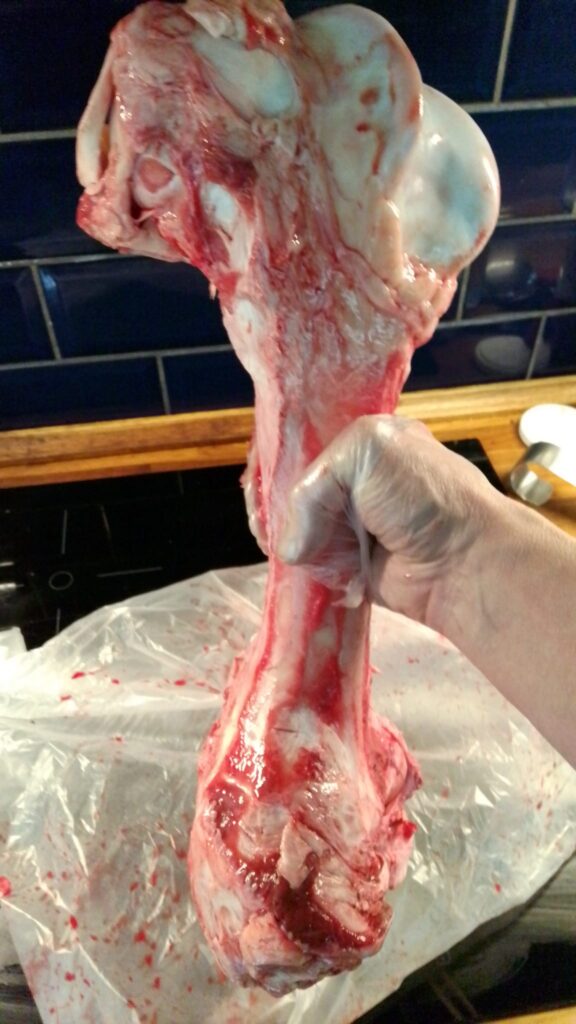
I was over the moon when the butcher presented me with this. I have a chop saw so was able to cut it into 3 or 4 pieces. I’m sure he would have done it for me but I’m getting it for free so I’m not going to push my luck.

This was 10lbs of smaller bones enough to do two lots, I put half in the freezer.
What I do…
This is proper rustic cooking, there is no finesse involved. Put the oven on around 200C. No need to peel anything. Chop the onions in half, skin on, cut the celery and carrots into 2-3 inch pieces, leaves and skin on, bruise the garlic with the back of a knife or the palm of your hand if you’re feeling manly. Put it all in a roasting tin. Place the bones on top of the veg, and put the tin in the oven. You are aiming at browning the bones and veg. After about 20 mins turn the bones. Keep checking the bones aren’t burning, no need to be finicky but you don’t want to cremate them. You will find quite a lot of liquid is accruing in the tin, this is fat, marrow, and veg juice and is fab. After around 40 mins take the tin out and paste/brush the bones with tomato puree as best you can. It doesn’t tend to adhere very well because of the hot fatty meat juices but do what you can. Return the tin to the oven. When the puree has caramelised remove the tin. Put the bones into whatever you’re using as a stock pot. Carefully pour as much of the accrued liquid into the pot as you safely can. Put the roasting tin back in the oven and brown the veg. When the veg is brown or you are bored tip it and any liquid into the stock pot. If the roasting tin has some brown bits stuck to it, use a little water and scrape the tin clean, add that to the pot.
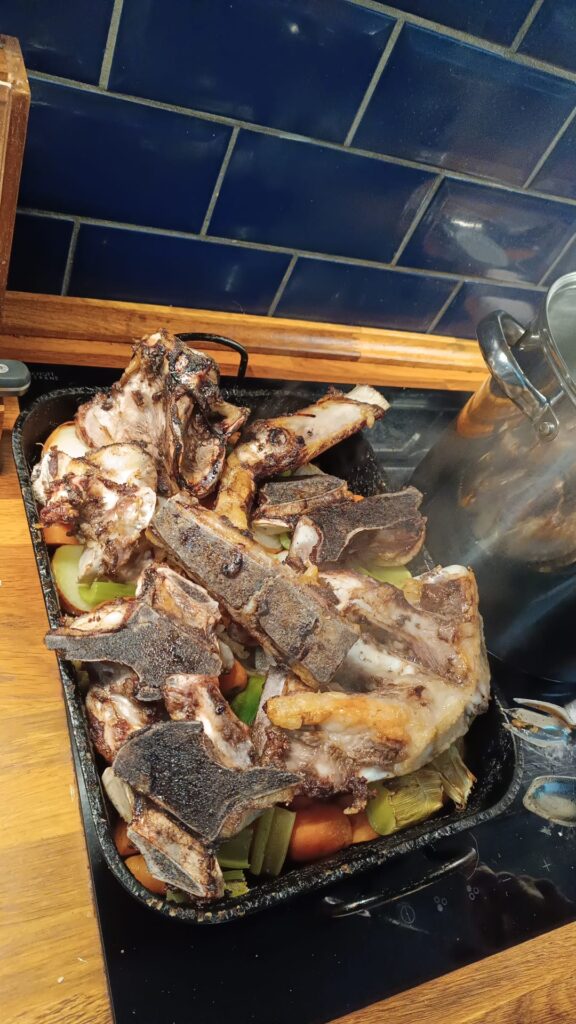
Just turning the bones part way through.
Add the herbs & peppercorns to the pot. Now cover the bones with water. It’s a good idea to use a measuring jug to add the water so that you know how much you’re using. You wont lose much liquid in the cooking process so what you add is more or less what you’ll end up with.
Bring the pot to a boil then reduce the heat to very low and put the lid on. You’re going to simmer this for at least 12 hours (overnight?), ideally 16+hrs. When I say simmer I mean you should see an occasional bubble not a constant maelstrom.
I stir mine every few hours but that’s more out of curiosity than anything. Your house will smell like a fabulous bistro.
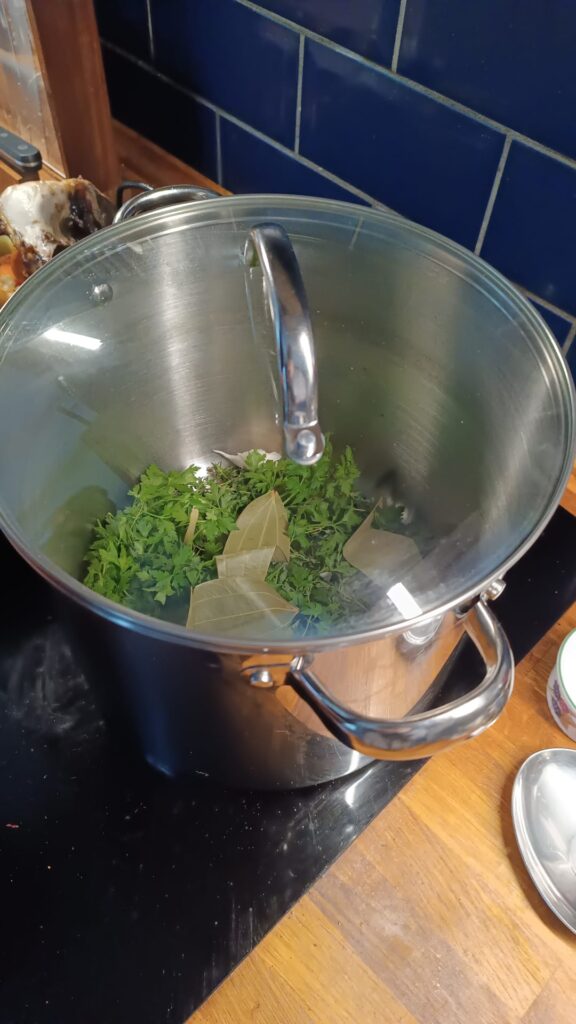
Herbs and peppercorns added to my 11 litre stock pot.
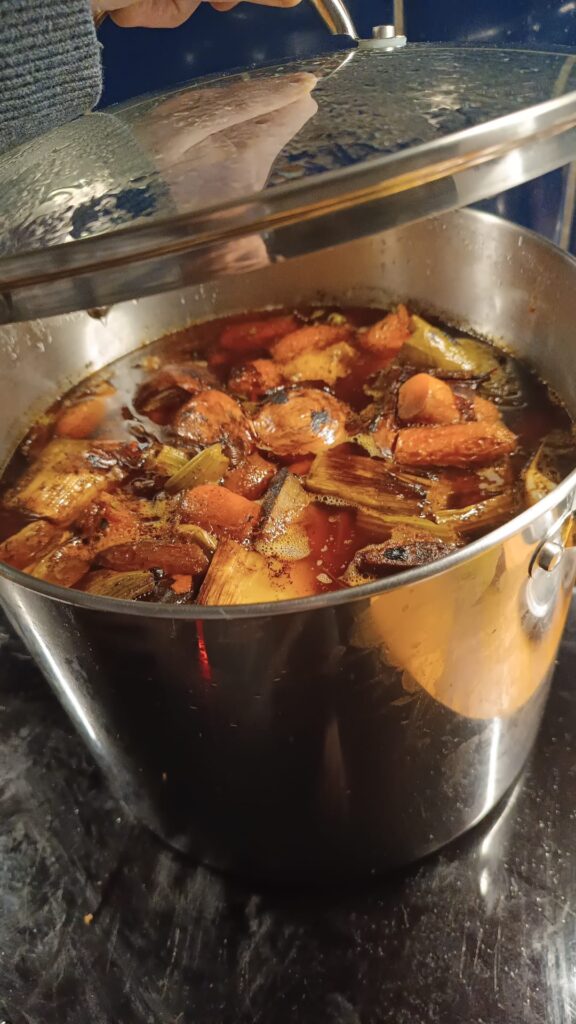
Just checking, it’s coming along nicely.
When you can’t wait any longer turn off the heat and remove the big bits that you can grab with a slotted spoon or tongs etc. Make sure they drip as much liquid back into the pot as possible. You’re going to need to strain the remaining contents of the pot. I find a fine sieve is enough but you may want to use some cheese cloth or muslin, if you do then be prepared for a long job. With a large pot of very hot liquid I find it easier to use a jug to scoop out the majority of the liquid and pour it into a sieve. Personally I end up with a lot of liquid and tend to sieve it into a couple of large saucepans. Press the solids in the sieve to get as much of the flavour out and into your stock.
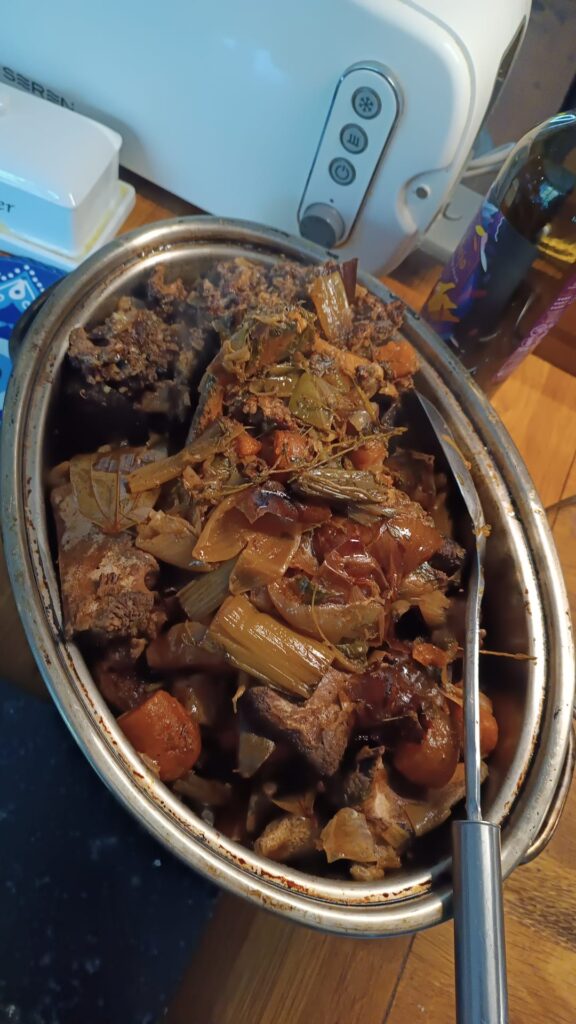
Your stock is almost finished at this point. But it’s going to have a lot of fat from the bones in it. You have the option of ladling the fat off, now. I don’t, I prefer to let the fat solidify. Either way, you need to cool it as quickly as possible. It need to end up in the fridge or cold enough for the fat to solidify. The solid fat can be removed and saved, it’s the bonus of making your own stock, use the fat for cooking steak or roast potatoes etc it’s brilliant stuff.
Please don’t do what I do, at best it’s messy but it’s potentially dangerous (sharp knife).
I funnel the warm stock it into empty 2 litre coke bottles. These can stand in cold water, or go outside in cold weather, they can go in the fridge once they have cooled enough. Don’t fully tighten the lids with hot liquid in them, they will contract. The refridgerated stock will form a thick layer of solid fat on top. This is where it gets messy and dangerous so don’t do it. I hold the plastic bottle over the empty stock pot and using a very sharp knife I cut the bottom of the bottle open allowing the jellified stock to flop out into the pot leaving the fat in the top of the bottle. A bit more cutting gives me access to the fat which I can spoon/scrape out.
So now you have several litres of jelly like stock and a jar of orangey brown highly flavoured fat. The stock you can use straight away for whichever recipe is calling for its use. Or you can stick it back on the hob and reduce it further, all you are doing is removing water and therefore intensifying it. If you reduce 2 litres down to 1 litre then it takes up less storage room and can be made back up to 2 litres by adding a litre of water. I go a lot further and reduce down to about a 25% of the original volume. This can be put into ice cube trays or silicon muffin trays etc. If you cool these in the fridge to allow the stock to return to jelly they can then be easily frozen. Once frozen I actually go a bit further and vacuum pack the frozen stuff.